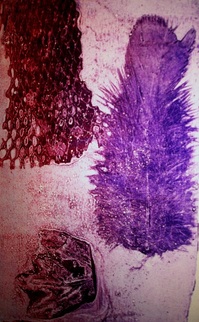 This Saturday, I'm offering a gelatin monotypes workshop at the Howard County Center for the Arts, in Ellicott City, MD. I've taught this technique at the National Museum of Women in the Arts, the Creative Alliance, School 33, and the Greenbelt Community Center, and it is always a lot of fun! This will be my first time offering it at my new location. Printing without a Press: Gelatin Monotypes Saturday, May 4, 3 - 6 p.m., $60, materials included. Please register here by Thurs. May 2. Create one-of-a-kind, painterly prints using gelatin as a printing surface. Ink transfers beautifully from the smooth gelatin surface, with very little pressure. The material is very versatile, and while it can mimic traditional printing processes, it possesses its own unique qualities and the process lends itself to experimentation. Participants will be instructed in a variety of techniques, and then create a set of experimental prints. A little bit about the process:  An inked gelatin plate, with stencils placed on top. Gelatin monotype printing is a low-tech, non-toxic form of printmaking that requires no press and used water-based inks or paint (we will be using akua kolor inks). The printing plate is made from a simple gelatin recipe.  Ghost print (left) Direct print (right) Ink can be painted directly onto the plate with brushes and then printed onto paper. The ink transfers easily with very little pressure. Of course, there will be a little ink left on the plate, which is perfect for creating "ghost prints."  Press nature specimens or textured items into the ink to capture and print the incredible detail. Feel free to bring plant trimmings or other textures you'd like to try printing!  You can also cut your own stencils for blocking out on the gelatin.  They can be used alone for a high contrast design,  or printed in layers, for more emphasis on texture, color layering, and transparency, or even to create a pattern.  You can even cut and carve your gelatin for a relief technique, using clay tools cookie cutters. Create patterns, line work, or cut "puzzle pieces" that can be inked separately and put back together for printing. I always save this step for last since it permanently changes the plate! Try these techniques and more at my workshop on Saturday! You will walk away with a stack of experimental prints and a recipe to make your own gelatin plate for printing. All experience levels welcome!
1 Comment
|
Amanda
I'm a woodblock printmaker who is committed to a non-toxic (or less toxic) art practice. I started out as a painter but found my way to printmaking through a love of paper and process. I seem to be falling for papermaking in the same way. I went to Syracuse University, where I studied painting (BFA) and museum studies (MA). I was a Resident Artist at the Howard County Center for the Arts for five years and previously worked at the National Museum of Women in the Arts. This blog is for posting works-in-progress and new works, as well as a few creative projects I've done with my kids. Archives
November 2019
Categories
All
Blogger Archive |
 RSS Feed
RSS Feed
